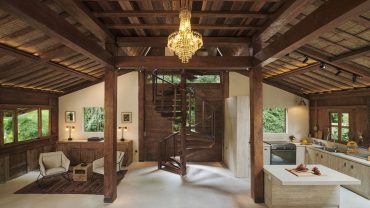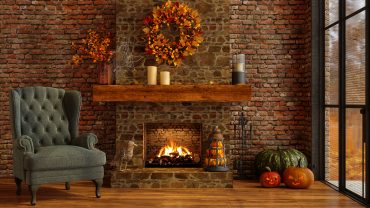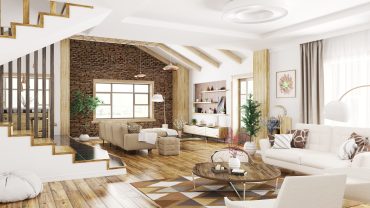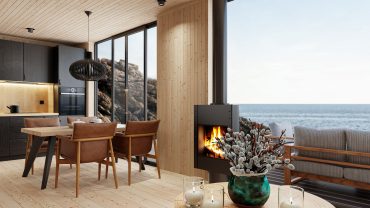Epitomised by the works of Jules Verne and HG Wells, steampunk was the science fiction subgenre of a future as envisaged in the 19th century.
As a style, steampunk is the junction where the industrial age’s raw functionality meets the ornate aesthetics of the Victorian era. This unique style of decor is marked by a fascinating blend of retrofuturistic machinery and antique opulence, creating a look that is both nostalgic and boldly futuristic.
But exactly what is steampunk interior design in practice? What does it take to achieve the tenuous balance of the steampunk interior design style? Read on and find out.
What is Steampunk Interior Design?

Steampunk interior design (Credit: bulgac via Getty Images)
Steampunk interior design is rooted in the aesthetic principles of the steampunk literary genre. Steam punk interiors draw from the late 19th-century Victorian era, juxtaposed with anachronistic technological motifs.
This design style embodies a fusion of old-world charm and speculative fiction, creating spaces that are richly detailed and visually intriguing. Steampunk interiors are characterised by their use of industrial materials, ornate furnishings, and a palette that combines dark, rich tones with metallic accents.
So, how does this work in practice?
Key Characteristics of Steampunk Interior Design

Retro steampunk-style clock (Credit: Vladimir Zapletin via Getty Images)
Steam punk interiors are a mix of eras, influences and elements, including:
Industrial Influence
A defining feature of steampunk interiors is their heavy reliance on industrial elements. Common materials include metal, wood, and leather, often presented in their raw, unpolished forms, creating the rugged foundation characteristic of this style. Industrial artefacts like gears, pipes, and gauges are not merely functional but serve as decorative focal points, highlighting the beauty of mechanical ingenuity. The industrial influence in steampunk style decor is evident in furniture pieces like iron-framed coffee tables, exposed brick walls, and leather-bound trunks repurposed as storage solutions.
Victorian Elegance
Steampunk interior design style pays homage to the Victorian era through its incorporation of ornate furniture and luxurious fabrics. This influence is seen in the use of intricate patterns, rich textiles, and elaborate wallpapers. Velvet drapes, brocade upholstery, and tufted leather sofas are staples of steampunk interiors, adding a touch of historical elegance. The combination of these elements with industrial features creates a distinctive and harmonious blend of past and future.
Technological Motifs
Technology, particularly from the steam-powered era, plays a significant role in steampunk interior design. Clocks, steam engines, and typewriters are not only functional items but also serve as decorative elements. The visibility of mechanical parts, such as cogs and gears, is a hallmark of this style. Faux machinery and speculative inventions often adorn steampunk interiors, emphasising the imaginative aspect of the genre. These technological motifs imbue spaces with a sense of wonder and curiosity.
Colour & Lighting
The colour palette in steampunk interiors is typically composed of dark, rich tones contrasted with metallic hues. Shades of brown, black, and deep green are common, often accented with brass, copper, and gold. This combination creates a warm and inviting atmosphere, while also evoking the industrial past. Lighting is crucial in steampunk interior design, with an emphasis on ambient and accent lighting. Vintage-style fixtures, such as Edison bulbs, wrought iron chandeliers, and brass lamps, enhance the steampunk aesthetic and provide a nostalgic glow.
Art & Decorative Accents
From wall art depicting fantastical airships to sculptures featuring intricate clockwork, these elements underscore the theme’s creative depth. Steampunk style decor often incorporates elements from popular narratives of science fiction and fantasy from the period, such as the works of Jules Verne and H.G. Wells, inviting a literary richness into the physical space.
Creating a Steampunk Space

Steampunk staircase and walls (Credit: denisik11 via Getty Images)
Introducing steampunk interior design style into a contemporary setting involves a delicate balance. It’s essential not to overwhelm the space with too much ornamentation or machinery. A subtle incorporation of steampunk motifs can be achieved through the choice of thematic accessories and art, gradually blending more distinct pieces to ensure the space remains both functional and stylistically coherent.
Life Imitating Art

Steampunk lighting (Credit: Wirestock via Getty Images)
Incorporating elements of steampunk fiction into home design can transform a space into a visually rich and imaginative environment. Steampunk style decor, with its blend of Victorian aesthetics and science fiction, provides a plethora of ideas from literature that can be adapted into decor. Here are some ways to infuse steampunk elements from specific books into a home:
“The Difference Engine” by William Gibson and Bruce Sterling
Decorative Gears and Mechanical Art: Inspired by the computational machines in this novel, homeowners can decorate with gears, cogs, and mechanical wall art to echo the book’s focus on Babbage’s engines.
Victorian Furniture with a Twist: Dark wood furniture with ornate detailing and brass accents to mirror the Victorian setting, adding velvet upholstery for a luxurious touch.
“Mortal Engines” by Philip Reeve
Industrial Lighting Fixtures: Reflecting the mobile cities and machinery in Reeve’s world, incorporate industrial-style lighting such as pendant lights made from repurposed metal and floor lamps with a gear base.
Map and Blueprint Artwork: Display maps and blueprints of fantastical machines and cities as wall art to capture the spirit of adventure and invention.
“Leviathan” by Scott Westerfield
Biomechanical and Zoological Elements: Use art and sculptures that combine mechanical and biological forms, reminiscent of the living airships in Westerfeld’s book, to add an organic yet engineered feel to the space.
Aviation-Inspired Decor: Hang model airships and aeroplanes from the ceiling or display them on shelves to honour the aviation theme central to the novel.
By drawing inspiration from these steampunk novels, homeowners can create a space that’s both a tribute to the inventive worlds of steampunk literature and a unique expression of personal style.
Summarising Steampunk Interior Design Style

Steampunk interior design (Credit: MAXIM ZHURAVLEV via Getty Images)
Steampunk interior design is a unique and imaginative style that combines historical elegance with retrofuturistic motifs. By drawing on Victorian influences and industrial elements, steampunk interiors create a distinctive and engaging environment. This design style is characterised by its use of dark, rich colours, visible mechanical details, and a blend of ornate and industrial furnishings. Embracing steampunk style decor allows for the creation of spaces that are not only aesthetically pleasing but also rich in narrative and visual interest.












